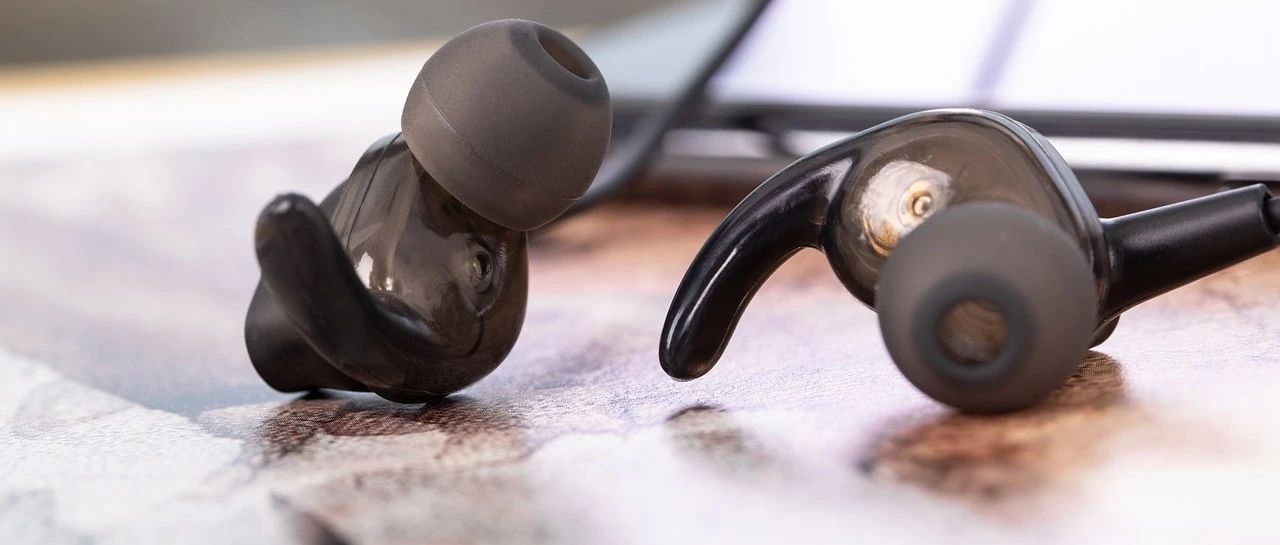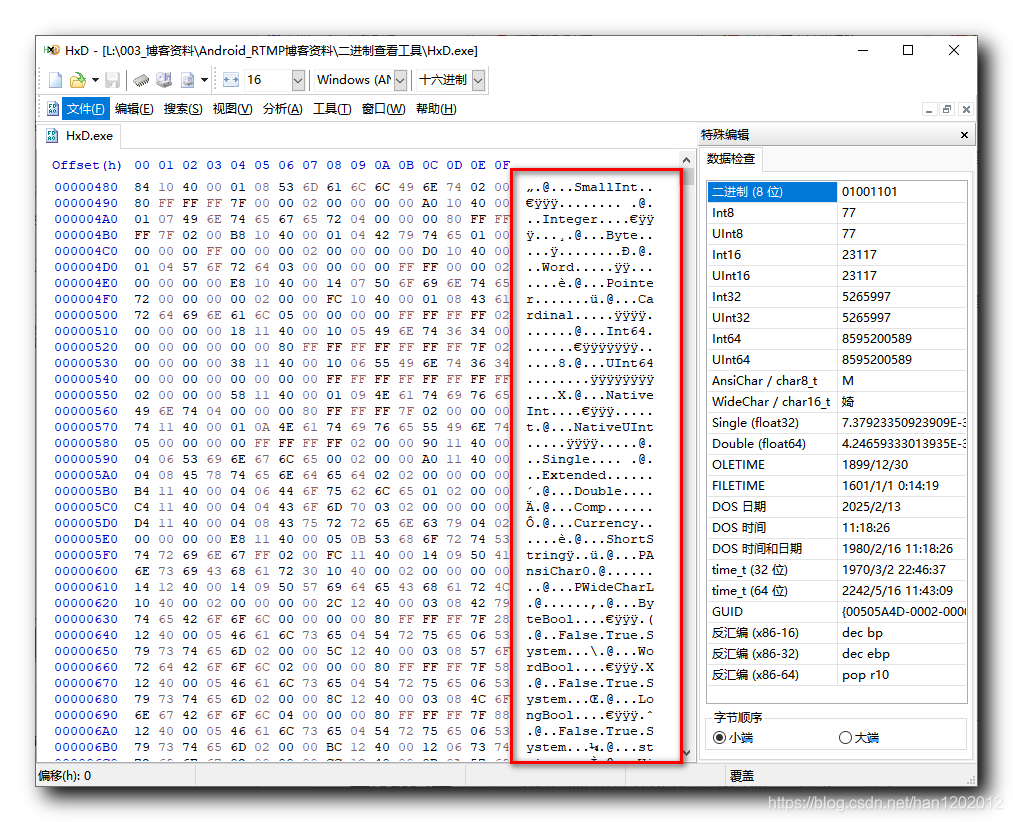Android 解析蓝牙广播数据
依据Android ScanRecord类的源码编写了ScanRecordUtil 类,扫描BLE设备,会获取byte[] scanRecord字节数组,可直接调用ScanRecordUtil.parseFromBytes(scanRecord).toString();获取广播中的信息,其他单独获取某个属性值与上类似,参照ble官方说明:https://www.bluetooth.com/specifications/assigned-numbers/generic-access-profile
import android.bluetooth.le.ScanRecord;
import android.os.ParcelUuid;
import android.support.annotation.Nullable;
import android.util.ArrayMap;
import android.util.Log;
import android.util.SparseArray;
import java.nio.ByteBuffer;
import java.nio.ByteOrder;
import java.util.ArrayList;
import java.util.Arrays;
import java.util.Iterator;
import java.util.List;
import java.util.Map;
import java.util.UUID;
/**
* Created by Huanglinqing on 2018/9/4/004.
*/
public class ScanRecordUtil {
/**
* Returns a string composed from a {@link SparseArray}.
*/
static String toString(SparseArray<byte[]> array) {
if (array == null) {
return "null";
}
if (array.size() == 0) {
return "{}";
}
StringBuilder buffer = new StringBuilder();
buffer.append('{');
for (int i = 0; i < array.size(); ++i) {
buffer.append(array.keyAt(i)).append("=").append(Arrays.toString(array.valueAt(i)));
}
buffer.append('}');
return buffer.toString();
}
/**
* Returns a string composed from a {@link Map}.
*/
static <T> String toString(Map<T, byte[]> map) {
if (map == null) {
return "null";
}
if (map.isEmpty()) {
return "{}";
}
StringBuilder buffer = new StringBuilder();
buffer.append('{');
Iterator<Map.Entry<T, byte[]>> it = map.entrySet().iterator();
while (it.hasNext()) {
Map.Entry<T, byte[]> entry = it.next();
Object key = entry.getKey();
buffer.append(key).append("=").append(Arrays.toString(map.get(key)));
if (it.hasNext()) {
buffer.append(", ");
}
}
buffer.append('}');
return buffer.toString();
}
private static final String TAG = "ScanRecordUtil";
// The following data type values are assigned by Bluetooth SIG.
// For more details refer to Bluetooth 4.1 specification, Volume 3, Part C, Section 18.
private static final int DATA_TYPE_FLAGS = 0x01;
private static final int DATA_TYPE_SERVICE_UUIDS_16_BIT_PARTIAL = 0x02;
private static final int DATA_TYPE_SERVICE_UUIDS_16_BIT_COMPLETE = 0x03;
private static final int DATA_TYPE_SERVICE_UUIDS_32_BIT_PARTIAL = 0x04;
private static final int DATA_TYPE_SERVICE_UUIDS_32_BIT_COMPLETE = 0x05;
private static final int DATA_TYPE_SERVICE_UUIDS_128_BIT_PARTIAL = 0x06;
private static final int DATA_TYPE_SERVICE_UUIDS_128_BIT_COMPLETE = 0x07;
private static final int DATA_TYPE_LOCAL_NAME_SHORT = 0x08;
private static final int DATA_TYPE_LOCAL_NAME_COMPLETE = 0x09;
private static final int DATA_TYPE_TX_POWER_LEVEL = 0x0A;
private static final int DATA_TYPE_SERVICE_DATA = 0x16;
private static final int DATA_TYPE_MANUFACTURER_SPECIFIC_DATA = 0xFF;
// Flags of the advertising data.
private final int mAdvertiseFlags;
@Nullable
private final List<ParcelUuid> mServiceUuids;
private final SparseArray<byte[]> mManufacturerSpecificData;
private final Map<ParcelUuid, byte[]> mServiceData;
// Transmission power level(in dB).
private final int mTxPowerLevel;
// Local name of the Bluetooth LE device.
private final String mDeviceName;
// Raw bytes of scan record.
private final byte[] mBytes;
/**
* Returns the advertising flags indicating the discoverable mode and capability of the device.
* Returns -1 if the flag field is not set.
*/
public int getAdvertiseFlags() {
return mAdvertiseFlags;
}
/**
* Returns a list of service UUIDs within the advertisement that are used to identify the
* bluetooth GATT services.
*/
public List<ParcelUuid> getServiceUuids() {
return mServiceUuids;
}
/**
* Returns a sparse array of manufacturer identifier and its corresponding manufacturer specific
* data.
*/
public SparseArray<byte[]> getManufacturerSpecificData() {
return mManufacturerSpecificData;
}
/**
* Returns the manufacturer specific data associated with the manufacturer id. Returns
* {@code null} if the {@code manufacturerId} is not found.
*/
@Nullable
public byte[] getManufacturerSpecificData(int manufacturerId) {
return mManufacturerSpecificData.get(manufacturerId);
}
/**
* Returns a map of service UUID and its corresponding service data.
*/
public Map<ParcelUuid, byte[]> getServiceData() {
return mServiceData;
}
/**
* Returns the service data byte array associated with the {@code serviceUuid}. Returns
* {@code null} if the {@code serviceDataUuid} is not found.
*/
@Nullable
public byte[] getServiceData(ParcelUuid serviceDataUuid) {
if (serviceDataUuid == null) {
return null;
}
return mServiceData.get(serviceDataUuid);
}
/**
* Returns the transmission power level of the packet in dBm. Returns {@link Integer#MIN_VALUE}
* if the field is not set. This value can be used to calculate the path loss of a received
* packet using the following equation:
* <p>
* <code>pathloss = txPowerLevel - rssi</code>
*/
public int getTxPowerLevel() {
return mTxPowerLevel;
}
/**
* Returns the local name of the BLE device. The is a UTF-8 encoded string.
*/
@Nullable
public String getDeviceName() {
return mDeviceName;
}
/**
* Returns raw bytes of scan record.
*/
public byte[] getBytes() {
return mBytes;
}
private ScanRecordUtil(List<ParcelUuid> serviceUuids,
SparseArray<byte[]> manufacturerData,
Map<ParcelUuid, byte[]> serviceData,
int advertiseFlags, int txPowerLevel,
String localName, byte[] bytes) {
mServiceUuids = serviceUuids;
mManufacturerSpecificData = manufacturerData;
mServiceData = serviceData;
mDeviceName = localName;
mAdvertiseFlags = advertiseFlags;
mTxPowerLevel = txPowerLevel;
mBytes = bytes;
}
/**
* Parse scan record bytes to {@link ScanRecord}.
* <p>
* The format is defined in Bluetooth 4.1 specification, Volume 3, Part C, Section 11 and 18.
* <p>
* All numerical multi-byte entities and values shall use little-endian <strong>byte</strong>
* order.
*
* @param scanRecord The scan record of Bluetooth LE advertisement and/or scan response.
* @hide
*/
public static ScanRecordUtil parseFromBytes(byte[] scanRecord) {
if (scanRecord == null) {
return null;
}
Log.e(TAG + "MYX23P", "进入parseFromBytes");
int currentPos = 0;
int advertiseFlag = -1;
List<ParcelUuid> serviceUuids = new ArrayList<ParcelUuid>();
String localName = null;
int txPowerLevel = Integer.MIN_VALUE;
SparseArray<byte[]> manufacturerData = new SparseArray<byte[]>();
Map<ParcelUuid, byte[]> serviceData = new ArrayMap<ParcelUuid, byte[]>();
try {
while (currentPos < scanRecord.length) {
// length is unsigned int.
int length = scanRecord[currentPos++] & 0xFF;
if (length == 0) {
break;
}
// Note the length includes the length of the field type itself.
int dataLength = length - 1;
// fieldType is unsigned int.
int fieldType = scanRecord[currentPos++] & 0xFF;
switch (fieldType) {
case DATA_TYPE_FLAGS:
advertiseFlag = scanRecord[currentPos] & 0xFF;
break;
case DATA_TYPE_SERVICE_UUIDS_16_BIT_PARTIAL:
case DATA_TYPE_SERVICE_UUIDS_16_BIT_COMPLETE:
parseServiceUuid(scanRecord, currentPos,
dataLength,16, serviceUuids);
break;
case DATA_TYPE_SERVICE_UUIDS_32_BIT_PARTIAL:
case DATA_TYPE_SERVICE_UUIDS_32_BIT_COMPLETE:
parseServiceUuid(scanRecord, currentPos, dataLength,
32, serviceUuids);
break;
case DATA_TYPE_SERVICE_UUIDS_128_BIT_PARTIAL:
case DATA_TYPE_SERVICE_UUIDS_128_BIT_COMPLETE:
parseServiceUuid(scanRecord, currentPos, dataLength,
128, serviceUuids);
break;
case DATA_TYPE_LOCAL_NAME_SHORT:
case DATA_TYPE_LOCAL_NAME_COMPLETE:
localName = new String(
extractBytes(scanRecord, currentPos, dataLength));
break;
case DATA_TYPE_TX_POWER_LEVEL:
txPowerLevel = scanRecord[currentPos];
break;
case DATA_TYPE_SERVICE_DATA:
// The first two bytes of the service data are service data UUID in little
// endian. The rest bytes are service data.
int serviceUuidLength = 16;
byte[] serviceDataUuidBytes = extractBytes(scanRecord, currentPos,
serviceUuidLength);
ParcelUuid serviceDataUuid = parseUuidFrom(
serviceDataUuidBytes);
byte[] serviceDataArray = extractBytes(scanRecord,
currentPos + serviceUuidLength, dataLength - serviceUuidLength);
serviceData.put(serviceDataUuid, serviceDataArray);
break;
case DATA_TYPE_MANUFACTURER_SPECIFIC_DATA:
// The first two bytes of the manufacturer specific data are
// manufacturer ids in little endian.
int manufacturerId = ((scanRecord[currentPos + 1] & 0xFF) << 8) +
(scanRecord[currentPos] & 0xFF);
byte[] manufacturerDataBytes = extractBytes(scanRecord, currentPos + 2,
dataLength - 2);
manufacturerData.put(manufacturerId, manufacturerDataBytes);
break;
default:
// Just ignore, we don't handle such data type.
break;
}
currentPos += dataLength;
}
if (serviceUuids.isEmpty()) {
serviceUuids = null;
}
return new ScanRecordUtil(serviceUuids, manufacturerData, serviceData,
advertiseFlag, txPowerLevel, localName, scanRecord);
} catch (Exception e) {
Log.e(TAG, "unable to parse scan record: " + Arrays.toString(scanRecord));
// As the record is invalid, ignore all the parsed results for this packet
// and return an empty record with raw scanRecord bytes in results
return new ScanRecordUtil(null, null, null, -1, Integer.MIN_VALUE, null, scanRecord);
}
}
@Override
public String toString() {
return "ScanRecord [mAdvertiseFlags=" + mAdvertiseFlags + ", mServiceUuids=" + mServiceUuids
+ ", mManufacturerSpecificData=" + ScanRecordUtil.toString(mManufacturerSpecificData)
+ ", mServiceData=" + ScanRecordUtil.toString(mServiceData)
+ ", mTxPowerLevel=" + mTxPowerLevel + ", mDeviceName=" + mDeviceName + "]";
}
/**
* byte数组转化为string
*/
static final char[] hexArray = "0123456789ABCDEF".toCharArray();
public static String bytesToHex(byte[] bytes) {
char[] hexChars = new char[bytes.length * 2];
for (int j = 0; j < bytes.length; j++) {
int v = bytes[j] & 0xFF;
hexChars[j * 2] = hexArray[v >>> 4];
hexChars[j * 2 + 1] = hexArray[v & 0x0F];
}
return new String(hexChars);
}
// Parse service UUIDs.
private static int parseServiceUuid(byte[] scanRecord, int currentPos, int dataLength,
int uuidLength, List<ParcelUuid> serviceUuids) {
while (dataLength > 0) {
byte[] uuidBytes = extractBytes(scanRecord, currentPos,
uuidLength);
serviceUuids.add(parseUuidFrom(uuidBytes));
dataLength -= uuidLength;
currentPos += uuidLength;
}
return currentPos;
}
// Helper method to extract bytes from byte array.
private static byte[] extractBytes(byte[] scanRecord, int start, int length) {
byte[] bytes = new byte[length];
System.arraycopy(scanRecord, start, bytes, 0, length);
return bytes;
}
/**
* 转化方法
* @param uuidBytes
* @return
*/
public static ParcelUuid parseUuidFrom(byte[] uuidBytes) {
if (uuidBytes == null) {
throw new IllegalArgumentException("uuidBytes cannot be null");
}
int length = uuidBytes.length;
if (length != 16 && length != 32 &&
length != 128) {
throw new IllegalArgumentException("uuidBytes length invalid - " + length);
}
// Construct a 128 bit UUID.
if (length == 128) {
ByteBuffer buf = ByteBuffer.wrap(uuidBytes).order(ByteOrder.LITTLE_ENDIAN);
long msb = buf.getLong(8);
long lsb = buf.getLong(0);
return new ParcelUuid(new UUID(msb, lsb));
}
// For 16 bit and 32 bit UUID we need to convert them to 128 bit value.
// 128_bit_value = uuid * 2^96 + BASE_UUID
long shortUuid;
if (length == 16) {
shortUuid = uuidBytes[0] & 0xFF;
shortUuid += (uuidBytes[1] & 0xFF) << 8;
} else {
shortUuid = uuidBytes[0] & 0xFF ;
shortUuid += (uuidBytes[1] & 0xFF) << 8;
shortUuid += (uuidBytes[2] & 0xFF) << 16;
shortUuid += (uuidBytes[3] & 0xFF) << 24;
}
long msb = BASE_UUID.getUuid().getMostSignificantBits() + (shortUuid << 32);
long lsb = BASE_UUID.getUuid().getLeastSignificantBits();
return new ParcelUuid(new UUID(msb, lsb));
}
public static final ParcelUuid BASE_UUID =
ParcelUuid.fromString("00000000-0000-1000-8000-00805F9B34FB");
}本文参与 腾讯云自媒体同步曝光计划,分享自作者个人站点/博客。
原始发表:2018年09月05日,如有侵权请联系 cloudcommunity@tencent.com 删除
评论
登录后参与评论
暂无评论
推荐阅读
编辑精选文章
换一批
推荐阅读
相关推荐
BLE 广播格式定义
更多 >









